George Mastras on Writing & Directing One of Breaking Bad’s Best Episodes
George Mastras has been a criminal investigator for the public defender’s office in Washington D.C., a counselor at a juvenile correctional facility during the crack epidemic of the 1990s, a litigator in New York, and a defense attorney in Los Angeles. Then he quit, bought a one-way ticket to China and backpacked around the world for two years. He wrote a novel while he was in Indonesia that was published by Scribner in early 2009 to very good reviews.
All of this would be impressive enough—but Mastras has also since become one of the best television writers in the business. He’s written for a little show called Breaking Bad since it premiered on January 20, 2008. The show returns for it’s final eight episodes this Sunday night (you may have heard)—and regardless of what outcome awaits meth drug lord and TV's reigning black hat Walter White, Mastras will go down as one of the most influential behind-the-scenes members of the Breaking Bad family.
Mastras's work on the show has won him awards and promotions. He's gone from story editor to executive story editor, from executive story editor to producer, from producer to co-executive producer. He also went from writing episodes to directing—in fact, Mastras wrote and directed one of the greatest episodes in the show’s storied run—episode five from the first half of season five called “Dead Freight,” for which he was individually nominated for the 2012 WGA Award in Best Episodic Drama category.
“Dead Freight” is both an homage to westerns and Breaking Bad at it’s absolute Breaking Baddest—ambitious, tense, heartbreaking. It could also be argued that “Dead Freight” represented a true turning point for the show’s central relationship—the twisted father/son dynamic between Walter White and Jessie Pinkman.
The episode opens with a kid on a motorbike cruising through the desert. He stops and traps a tarantula. Back in Walter White’s world, his desire to grow his meth empire to Gus Fring heights might be stillborn. His supplier for methylamine, a crucial component for cooking meth, has been compromised by the police. There’s another way to get some, however—a train that carries tankers full of it. All the boys need to do is rob the train.
A train heist on many other TV shows would either be ham-fisted, off-screen, or otherwise goofy. On Breaking Bad it’s an operatic masterpiece. Mastras’s teleplay and direction are almost obscenely tense—on several different occasions throughout the episode you feel something terrible is about to happen, only for the scene to go another way…until the very end of the episode.
My god, that ending.
“Dead Freight” aired on August 12, 2012, and its impact was immediate. The A.V. Club, Rolling Stone, HitFix, IGN, Slate and many other outlets gave it rave reviews. Vulture called the train-heist sequence the year’s most suspenseful scene. The ending was hotly debated and genuinely shocking. According to this graphic by IMDB, “Dead Freight” is the second highest rated episode in the shows’ run, behind only the season four finale (Episode S5E5):
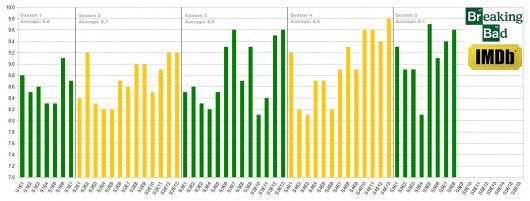
How the hell did Mastras and the Breaking Bad team pull this off? That’s what we wanted to find out.
The Credits: “Dead Freight” is one of the most ambitious episodes in Breaking Bad’s very ambitious history. How much changed between your original conception for the episode and what we saw when it aired?
Mastras: The interesting thing is that because I directed it, I was thinking about how to shoot it while I was writing it, so it was a huge advantage. Basically, we knew that Walt’s big problems were about empire building, so it became about figuring out how to replace their methylamine supply. He wanted to step up the level of Gus Fring, but the supplies were not there so we knew there would be a big heist to steal methylamine. So we thought, wouldn’t it be amazing if we could do a train heist?
A train heist is not the kind of thing most people could pitch in a writing room and have green lit.
It was an ambitious idea, and we thought it would probably get shot down, but we ran it by our producers and, lo and behold, there was this spur line that was used in Butch Cassidy and the Sundance Kid that was outside of Santa Fe, and it was a beautiful location.
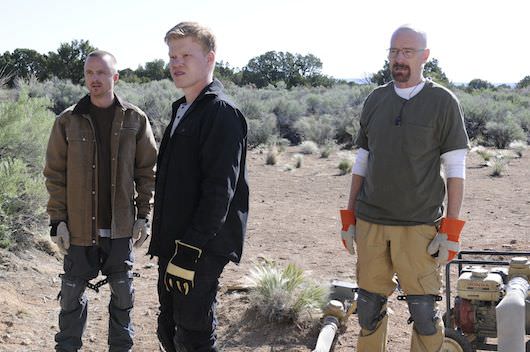
That was serendipitous.
Yeah, so now I knew that I would be able to do this fantastic train heist, so I was able to fly out there early. Normally when you direct an episode of Breaking Bad, you get to go a couple of weeks early, but I flew out a month earlier and was able to look at the location. So it was a huge advantage to be able to write for the location.
So how did the idea of transferring water into the train's tankers to replace the methylamine and doing that weight distribution dance happen?
There was an incredible amount of research that went into it to actually make it work. Because Breaking Bad loves science, we needed for it to be grounded in reality, so I reached out to various experts on transportation of hazardous waste as well as our train expert, the person who actually ran that spur line. There are a couple of things that we learned, and one is that methylamine, being hazardous, is weighed when the tank’s loaded and again when it's unloaded, so that was a way that they would know whether or not this stuff was stolen. People do try and steal this stuff because it’s a Schedule 1 substance and is carefully watched.
The problem is methylamine is actually lighter than water, so we had to work out the proportions, which we had a chemistry professor help us with. With a lot of it, we usually started with our own research and then trained experts verified it all.
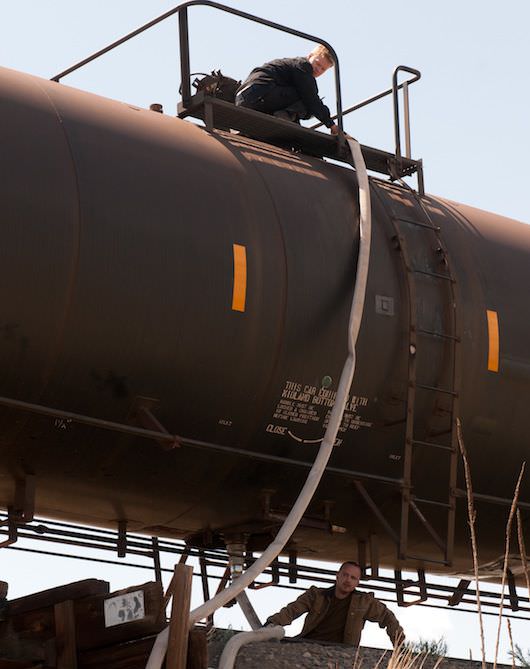
So how long did it take to shoot “Dead Freight” versus a regular, non-epic train robbery episode?
A normal shoot on Breaking Bad is seven to eight days, and this one was ten days. We had to put the entire crew up [in Santa Fe], we were there for five days and shooting for four days, and that’s just the train heist aspect of it. We have the kid on the motorbike to shoot, and then there was a whole act in this crazy, dungeon-like location.
There seemed to be a ton of moving parts to the actual heist.
The train and the technical aspects of it made it a much more complex shoot. If you look at the heist and break it down on filmmaking terms, there are a number of things going on. You’ve got a guy rolling out this generator and running hoses up the hill, you have the action on the train itself, action on top of the train, action under the train, action with the wrenches, with the hoses, you have the stuff that’s going on inside of the train, the stuff that’s going on at the intersection, the stalled truck, the good Samaritan that stops to help with the stalled truck, you’ve got Mike watching all of this, and not to mention all the cameras that are mounted on the train!
How many cameras?
This train is travelling through the valley and has cameras below, cameras on top, cameras on the wheels, and there’s a camera on a crane. My opening shot was the train coming right at the camera, then the camera swoops down and reveals this guy under the bridge holding hoses, almost like they are soldiers in the trenches in WWI. All that stuff just made it a very massive undertaking. People kept telling me if it was a feature film we would have had a month to shoot it, but we did it in 4 or 5 days.
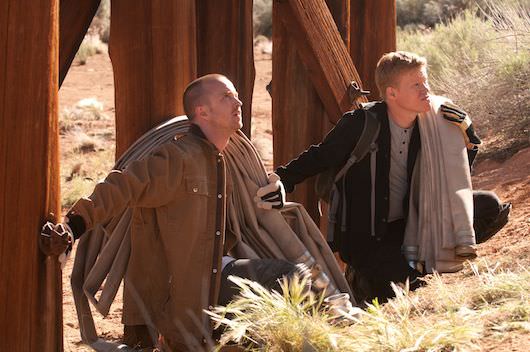
Let’s talk about the ending. When you were first conceiving of “Dead Freight,” did you have that heart-breaking end in mind? (SPOILER ALERT)
Yeah, that was in the script and it was hotly debated, the kid being shot at the end. It’s Breaking Bad, so the question being asked was, ‘What are the consequences of their actions?’ And up until that point in the entire series, there hadn’t been some sort of innocent bystander who was a victim, and that was the next big moral step. So then the question was, ‘Where does this lead us?’ It’s really that moment that I think is the turning point. It obviously led to the dissolution of this partnership between Jesse and Walt, so there was a long debate.
It's such a perfectly horrible moment—just when you think they've pulled it off without any bloodshed…
Yeah, everything seems to be going right for Walt, he was confident and he had ascended to power. And so there was a big debate over whether this heist would just go off, and I think we felt that there needed to be consequences in Breaking Bad. I felt when I was first writing this episode that it was a microcosm for the entire series, because it takes you on this wild thrill ride and you get lost in the center during the thrills of the heist, but we challenge the audience. Who are you rooting for? You’re rooting for the bad guys. We can kill all the people who are involved, your Gales, for example, people who are involved in the game, but there are innocent victims of what these people are doing, and to a certain extent we need to give a voice to those victims if we want this to feel real.
The episode opens on the kid on the motorbike, and as wised up 21st century television viewers, we know it has to come back to him, and yet I totally forgot about him because the rest of the episode was so tense.
Yes, that’s exactly right. That’s why I would say this episode is about the consequences of their actions. I have this teaser, and my goal as a writer and director was to get the audience to forget completely about this kid until we see him at the very end. To do that, I wanted to sweep the audience up in this heist and get them so involved in the suspense of it they forget everything else. Before the kid, they had made the decision that, “We don’t do this if we have to kill an innocent victim.” [Jesse refused to participate if they had to kill the train’s engineer and conductor, hence the wild scheme with switching out the methylamine for the water.] That’s all fine to say, but what are you guys actually doing? You are cooking meth; you are killing kids. So that’s why ["Dead Freight] is like a microcosm of the season— people try to rationalize what they’re really doing.
It does feel like it's the first thing to happen that's absolutely indefensible. Even when Walt poisoned Brock in season four, you could rationalize that he could have saved him…
Well, they're meth cooks, they are hurting children everyday, so to allow for that to just go by just didn’t sit very well with us. So I think the ending to “Dead Freight” is bringing that to the forefront, and it challenges the audience: how long are you going to root for these people? To me, that was a really horrible thing and I was very torn, but I felt very necessary.
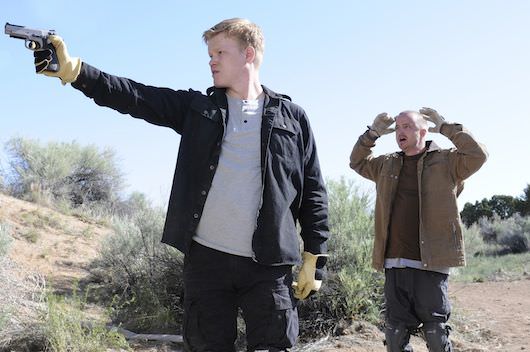
Last question; what happens in the last episode of the series? You can trust us.
[Publicist]: Okay, our time’s up.
Featured image: Walter White (Bryan Cranston) and Jesse Pinkman (Aaron Paul) Photo Credit: Frank Ockenfels 3/AMC



